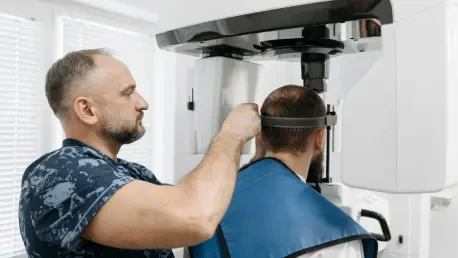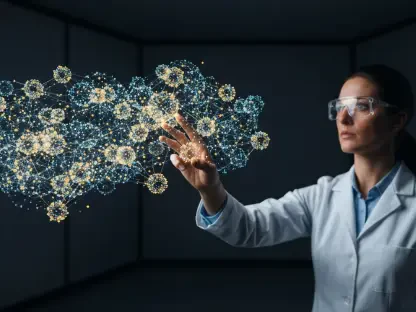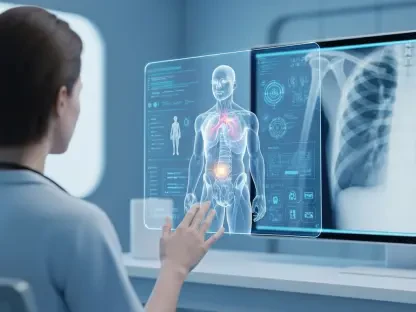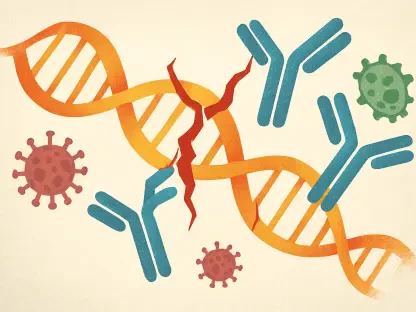Artificial Intelligence (AI) has swiftly transitioned from speculative technology to a cornerstone of modern medical diagnostics, heralding a new era of healthcare innovation. As AI technologies integrate deeper into clinical settings, they are transforming the landscape of diagnostics by improving accuracy, efficiency, and accessibility. Machine learning and deep learning algorithms are at the forefront, enabling the processing of complex medical datasets, which leads to early detection and timely interventions. The increasing reliance on AI in diagnostic practices isn’t just about convenience; it’s reshaping how diseases are understood, predicted, and treated, revolutionizing the entirety of patient care processes.
Transformative AI Applications in Diverse Medical Fields
AI’s transformative impact in medical diagnostics is evident across various disciplines, profoundly enhancing accuracy and speed. In radiology, AI algorithms are functioning as indispensable tools, capable of interpreting X-rays and MRI scans with exceptional precision. These systems can uncover anomalies in imaging that might otherwise elude human specialists, offering insights into detecting conditions like lung nodules and bone fractures at an early stage. Pathology, traditionally reliant on meticulous manual analysis, is now embracing AI-driven solutions for the rapid identification and assessment of cancerous cells. By examining biopsy images, AI systems improve diagnostic accuracy, ultimately providing patients with timely and tailor-made treatment options.
Similarly, cardiology has experienced considerable advancements through AI-enabled analyses of electrocardiograms (ECGs), which empower the early detection of arrhythmias and potential cardiac events before symptoms fully manifest. Genomics is another field witnessing remarkable progress; AI facilitates swift evaluation of extensive genetic data, identifying individual disease risks and crafting personalized therapeutic strategies. Moreover, Natural Language Processing (NLP) tools enrich clinical decision-making by analyzing electronic health records, seamlessly offering real-time diagnostic recommendations. This cross-disciplinary deployment of AI underscores its potential in rendering diagnosis more precise and efficient, promising transformative outcomes for patients globally.
Emerging Trends in AI Diagnostics
In the realm of AI diagnostics, recent developments from 2025 onwards reveal significant advancements that are reshaping healthcare. Foundation models, such as OpenAI’s GPT-4 and Google’s Med-PaLM, are now ubiquitous, serving as the backbone for seamlessly integrating multiple data forms like text and images. This multimodal integration allows for comprehensive analysis of radiology images coupled with pertinent clinical notes, facilitating a holistic diagnostic approach. Alongside these innovations, generative AI enhances low-resolution medical images, creates synthetic data for training, and simulates rare diseases, thus expanding diagnostic stability, especially for rare conditions.
Data privacy remains a pivotal concern, addressed through technologies like federated learning, which allows AI models to train without compromising patient confidentiality. This method enables collaboration across healthcare facilities without necessitating data sharing, safeguarding sensitive information while ensuring robust model training. The growth of Explainable AI (XAI) further enhances clinician trust in AI diagnostics by elucidating model predictions, often through visual aids like heatmaps. As AI applications increase, the integration with wearable devices gains traction, enabling remote monitoring and early detection of ailments, such as sepsis and atrial fibrillation, ultimately leading to faster interventions and improved patient care.
Market Growth and Regulatory Developments
The AI diagnostics market is witnessing an impressive expansion, driven by technological advancements and increased demand for early disease detection. Projections indicate the global market will reach an estimated USD 1.59 billion in the near future, bolstered by a compound annual growth rate of 22.46%. This growth is largely fueled by the heightened need for early diagnostic tools in critical medical fields such as oncology, cardiology, and neurology, which focus on enhancing patient outcomes and optimizing healthcare services. Industry leaders include innovative startups like PathAI and Aidoc, alongside global tech giants Google Health and Amazon HealthLake, all of whom are spearheading AI diagnostic innovations.
Regulatory landscapes are evolving in tandem, with the U.S. Food and Drug Administration approving a significant number of AI and machine learning-based medical devices, exemplifying the regulatory commitment to supporting AI innovations. Regulators are also developing frameworks to accommodate adaptive algorithms and continuous learning systems, which ensure compliance and uphold patient safety standards as AI technologies evolve. The dynamic interaction between technological progress and regulatory governance is steering AI diagnostics toward greater public trust and widespread adoption across healthcare sectors, ensuring that technological improvements translate into tangible patient benefits.
Challenges and Considerations in AI Implementation
Despite the promising progress in AI diagnostics, several challenges impede its full implementation in clinical settings. One significant challenge involves addressing bias and fairness in AI models, often arising from training datasets that lack diverse representation. These biases can inadvertently perpetuate existing health disparities, highlighting the necessity for equitable data inclusion. Seamlessly integrating AI diagnostics into clinical workflows requires robust infrastructure and adequate clinician training to fully leverage AI’s capabilities, making clinician education a critical component in the adoption process.
Legal considerations concerning accountability and liability for AI-assisted diagnostic errors require clear framework development to instill confidence among healthcare providers. Ensuring high-quality input data is another crucial aspect, as the model’s effectiveness depends significantly on the quality of data. Inconsistent or noisy data inputs can substantially undermine AI’s diagnostic accuracy, requiring healthcare systems to prioritize data quality assurance. Addressing these challenges is vital for the successful integration of AI in diagnostics, ensuring the technology’s potential is fully realized without compromising patient safety or care standards.
The Future Trajectory of AI in Medical Diagnostics
Artificial Intelligence (AI) has made rapid strides from being a speculative concept to becoming a crucial element in modern medical diagnostics, initiating a new wave of innovation in healthcare. As these AI technologies become increasingly embedded within clinical environments, they are revolutionizing diagnostic methodologies by enhancing precision, speed, and accessibility. At the forefront of these advancements are machine learning and deep learning algorithms, which facilitate the analysis of intricate medical datasets, leading to the early detection of conditions and timely interventions. The growing reliance on AI in diagnostic processes extends beyond mere convenience; it is fundamentally altering how we understand, forecast, and manage diseases, thereby transforming the entirety of patient care. This evolution in the diagnostic approach promises a future where healthcare is more proactive, personalized, and predictive, aiming toward improved patient outcomes and streamlined treatment protocols.









